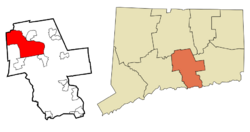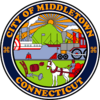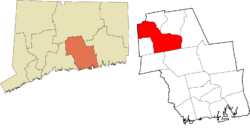Middletown, Connecticut facts for kids
Quick facts for kids
Middletown
|
|||
|---|---|---|---|
| City of Middletown | |||

Middletown skyline
|
|||
|
|||
| Nickname(s):
Forest City
|
|||
 Middlesex County and Connecticut Middlesex County and Connecticut |
|||
| Country | United States | ||
| U.S. state | Connecticut | ||
| County | Middlesex | ||
| Region | Lower CT River Valley | ||
| Incorporated (town) | 1651 | ||
| Incorporated (city) | 1784 | ||
| Consolidated | 1923 | ||
| Named for | Being halfway between Hartford and Saybrook on the Connecticut River | ||
| Government | |||
| • Type | Mayor-council | ||
| Area | |||
| • Total | 42.37 sq mi (109.72 km2) | ||
| • Land | 41.02 sq mi (106.24 km2) | ||
| • Water | 1.35 sq mi (3.49 km2) | ||
| Elevation | 135 ft (41 m) | ||
| Population
(2020)
|
|||
| • Total | 47,717 | ||
| • Density | 1,163.26/sq mi (449.14/km2) | ||
| Time zone | UTC−05:00 (Eastern) | ||
| • Summer (DST) | UTC−04:00 (Eastern) | ||
| ZIP Code |
06457
|
||
| Area code(s) | 860/959 | ||
| FIPS code | 09-47290 | ||
| GNIS feature ID | 02378281 | ||
| Interstates | |||
| U.S. Highways | |||
Middletown is a city in Middlesex County, Connecticut, United States. It is located along the Connecticut River, in the central part of the state. Middletown is about 16 miles (25.7 km) south of Hartford. It is the largest city in the Lower Connecticut River Valley Planning Region.
In 1650, English settlers made it a town. They used its original Native American name, Mattabeseck. This name came from the local Wangunk village. The colonists renamed the settlement Middletown in 1653.
Middletown became part of Hartford County in 1666. In 1784, the main settlement became a city separate from the town. Both were included in the new Middlesex County in 1785. In 1923, the city and town joined together. This made the city limits much larger.
Middletown was first a busy sailing port and then an industrial center. Today, it is mostly a place where people live. Its downtown area, especially Main Street, is popular for shopping, eating, and entertainment. It is also close to Wesleyan University. Middletown was the county seat of Middlesex County from 1785 until 1960.
As of the 2020 census, about 47,717 people live in Middletown. It is the southernmost city in the Hartford-Springfield Knowledge Corridor area. This larger area has a combined population of 1.9 million. Middletown is known for being a politically progressive city. It hosts one of the biggest pride events in Connecticut.
Contents
History of Middletown
The land where Middletown is now was once home to the Mattabesett Native Americans. The area was named after them. When the first European settlers arrived, the Mattabesetts were part of a group of tribes in the Connecticut Valley. Their chief was named Sowheag.
Plans for the settlement of "Mattabesett" were made in 1646. The first Europeans arrived in 1650 from other Connecticut colonies. The name Middletown was chosen because it was halfway between Windsor and Saybrook on the Great River. Life was hard for these early Puritan colonists. They had to clear land, build homes, and farm in the rocky New England soil.
Pequot Mohegans, who were allies of the English, came to Middletown in the late 1600s. This led to conflicts with the local Native American tribes. The Mattabesett called the Mohegan "destroyers of men." Chief Sowheag hoped the colonists would help, but they did not. Smallpox also affected the Mattabesett, weakening their ability to fight. Over time, Sowheag had to sell most of the Mattabesett land to the colonists. By 1676, the Puritans owned almost all of the land.
Growth and Trade in the 1700s
During the 1700s, Middletown became the largest and richest settlement in Connecticut. By the time of the American Revolution, it was a busy port. About one-third of its people worked in shipping and trade.
Slavery was also part of Middletown's early economy. African slaves were brought to the town in 1661. By 1756, Middletown had the third-largest African slave population in Connecticut. There were 218 slaves compared to 5,446 white residents.
Middletown traders wanted to clear the Saybrook Bar at the mouth of the Connecticut River. They also pushed for the creation of Middlesex County in 1785. The county was named 'Middlesex' because they wanted Middletown to be a major river port, like London in Middlesex County, England. They also built the Middlesex Turnpike (now Route 154). This road connected all the settlements on the west side of the Connecticut River.
Challenges and New Industries in the 1800s
The port began to decline in the early 1800s. This was due to problems between America and Britain, which led to the War of 1812. The port never fully recovered. However, Middletown played an important role in the war. Commodore Thomas Macdonough from Middletown led American forces to victory on Lake Champlain in 1814. This ended British hopes of invading New York.
During this time, Middletown became a major center for making firearms. Many gun makers in the area supplied most of the pistols to the U.S. government during the War of 1812. After the war, this business moved to other cities like Springfield, Hartford, and New Haven.
In 1831, Wesleyan University was founded. It became one of the top liberal arts schools in the United States. The people of Middletown built the first two main buildings to attract an academic institution. In 1841, Middletown opened the state's first public high school.
The mid-1800s saw manufacturing replace trade as Middletown's main economy. However, industrial growth was limited because railroads bypassed Middletown. There was a plan to build a railroad suspension bridge nearby, but it was not practical.
Middletown in the Civil War
People from Middletown played a part in the Civil War. General Joseph K. Mansfield from Middletown was a Union General. He died in action at Antietam in 1862. Another general, George Taylor, who studied in Middletown, also died at Antietam. The popular Civil War song "Marching Through Georgia" was written by Henry Clay Work, who lived in Middletown. The city was also active in the abolitionism movement. It was a stop on the Underground Railroad, which helped slaves escape to freedom.
In the late 1800s, manufacturing was the city's main business. They made fine metal parts like marine hardware and typewriters. There were also several machine tool companies. Middletown was home to a large unit of Goodyear. The pioneer automobile maker Eisenhuth Horseless Vehicle Company was also here.
Middletown even had a major-league baseball team for a short time, the Middletown Mansfields.
Changing Population and Modern Times
In the late 1800s and early 1900s, Middletown's population changed a lot. First, Irish immigrants arrived, then many Italians. Many came from the town of Melilli, Sicily. Polish and German immigrants followed. By 1910, the population grew to almost 21,000. Later, more African-Americans moved to the area, followed by Hispanic residents.
Two professors from Wesleyan University helped bring a small group of Cambodian refugees to Middletown in the early 1980s. This led to a growing Cambodian community. A similar story is true for Middletown's small Tibetan community. Middletown is also home to the first Hindu temple in Connecticut. This has attracted a Hindu population. This mix of people has made Middletown known for its wide variety of restaurants.
Natural events and new people continued to shape the city in the early 1900s. Middletown was hit by floods in 1927 and 1936. The Great New England Hurricane hit in 1938. Despite these events, the Arrigoni Bridge was finished in 1938. It crosses the Connecticut River and connects Middletown to Portland.
In the 1950s, cars became very popular. Officials built a highway that separated Middletown from the Connecticut River. This highway construction destroyed old neighborhoods and historic buildings. People moved to newer homes outside the older areas. Middletown, like many other cities in the Northeast, saw a decline. This did not change until the 1990s.
During this time, many beautiful but old buildings were torn down for "urban renewal". They became parking lots or were left empty. Crime also increased. In the 1960s, Pratt and Whitney Aircraft opened a large factory in Middletown. Developers also bought many farms to build suburban homes for workers.
In the 1970s, Oddfellows Playhouse was started. This theater attracts hundreds of young people each year. They come from all over the state to perform in plays. It is one of the few youth theaters in Connecticut. It is located near Middletown's famous Main Street.
In the 1990s, the city, the Middlesex Chamber of Commerce, and Wesleyan University worked together. They invested a lot in Middletown's Main Street. Their efforts helped downtown Middletown become lively again. Crime went down, and new restaurants and shops opened.
The Samuel Wadsworth Russell House on High Street was built in 1827. It was named a National Historic Landmark in 2001. The Alsop House, also on High Street, was built in 1840. It became a National Historic Landmark in 2009. Both buildings are part of the Wesleyan University campus.
Geography and Nature
Middletown is on the west bank of the Connecticut River. It is in the south-central part of Connecticut. Route 9 runs alongside the river and cuts through the city.
The city covers about 42.3 square miles (109.6 km²). Most of this is land (40.9 square miles or 105.9 km²). About 1.4 square miles (3.7 km²) is water.
The west side of Middletown has the Metacomet Ridge. This is a rocky mountain range that goes from Long Island Sound almost to the Vermont border. Important mountains in Middletown that are part of this ridge include Higby Mountain and the north side of Lamentation Mountain. The 50-mile (80 km) Mattabesett Trail runs along this ridge. The Nature Conservancy helps protect the top and rocky areas of Higby Mountain.
People and Population
| Historical population | |||
|---|---|---|---|
| Census | Pop. | %± | |
| 1810 | 2,014 | — | |
| 1820 | 2,618 | 30.0% | |
| 1830 | 3,123 | 19.3% | |
| 1840 | 3,511 | 12.4% | |
| 1850 | 4,211 | 19.9% | |
| 1860 | 5,182 | 23.1% | |
| 1870 | 6,923 | 33.6% | |
| 1880 | 6,826 | −1.4% | |
| 1890 | 9,013 | 32.0% | |
| 1900 | 9,589 | 6.4% | |
| 1910 | 11,851 | 23.6% | |
| 1920 | 13,638 | 15.1% | |
| 1930 | 24,554 | 80.0% | |
| 1940 | 26,495 | 7.9% | |
| 1950 | 29,711 | 12.1% | |
| 1960 | 33,250 | 11.9% | |
| 1970 | 36,924 | 11.0% | |
| 1980 | 39,040 | 5.7% | |
| 1990 | 42,762 | 9.5% | |
| 2000 | 43,167 | 0.9% | |
| 2010 | 47,648 | 10.4% | |
| 2020 | 47,717 | 0.1% | |
| U.S. Decennial Census | |||
As of the census of 2020, Middletown had 47,717 people living there. There were 20,089 households, with about 2.14 people per home. The population density was about 1,163 people per square mile (449 per km²).
There were 21,549 housing units. About 54% of homes were owned by the people living in them. The average value of these owned homes was $240,700.
The city's population was made up of different groups:
- 66.2% White (not Hispanic or Latino)
- 15.7% Black or African American
- 10.9% Hispanic or Latino
- 5.7% Asian
About 11.9% of residents were born in other countries.
About 15.5% of residents were under 18 years old. About 16.2% were 65 years or older. The average age was 39.5 years.
The average income for a household in the city was $62,022. For individuals, the average income was $39,845. About 12.3% of the population lived below the poverty line.
Economy and Jobs
Top Employers in Middletown
Here are the top employers in Middletown, based on a 2022 report:
| # | Employer | # of Employees |
|---|---|---|
| 1 | Middlesex Hospital | 3,131 |
| 2 | United Technologies | 2,986 |
| 3 | FedEx | 1,500 |
| 4 | Connecticut Valley Hospital | 1,100 |
| 5 | Wesleyan University | 1,023 |
| 6 | Middletown Board of Education | 908 |
| 7 | City of Middletown | 380 |
| 8 | Liberty Bank | 380 |
| 9 | Jarvis Products Corporation Kaman Corporation | 275 |
| 10 | Kaman Corporation | 269 |
Education in Middletown
Middletown has public schools, including Middletown High School.
There is one Roman Catholic elementary school, Saint John Paul II Regional Catholic School. There are also two Roman Catholic high schools: Xavier High School for boys and Mercy High School for girls.
Middletown also has a technical high school called Vinal Technical High School.
For higher education, there is Wesleyan University and Middlesex Community College.
The Russell Library is Middletown's public library. It offers books, newspapers, magazines, and online resources. It also has classes, computer training, workshops, concerts, and meeting spaces.
Media Outlets
Middletown has three main news sources:
- The Middletown Press: A daily newspaper covering local news.
- The Hartford Courant: A daily newspaper that includes Middletown stories.
- Radio stations: WMRD 1150 AM (variety), WESU 88.1 FM (Wesleyan University), and WIHS 104.9 FM (religious).
Transportation
River Valley Transit provides public transportation in Middletown. It also offers service between Middletown and Old Saybrook. From there, you can connect to Amtrak trains and Shore Line East commuter rail service.
The New Britain Transportation Company connects Middletown to New Britain. Connecticut Transit offers local and express bus service to Hartford and express service to New Haven.
The closest commercial airports are Bradley International Airport (BDL) in Windsor Locks and Tweed New Haven Airport (HVN) in East Haven.
Smaller airports for general aviation are Meriden Markham Municipal Airport in Meriden and Goodspeed Airport in East Haddam.
Notable Organizations
- Artists For World Peace: A nonprofit group working for peace around the world.
Notable People
This list includes people who were born in Middletown, currently live there, or lived there at some point.
Born in Middletown
- Dean Acheson (1893–1971): Was the 51st United States Secretary of State.
- Joseph Wright Alsop IV: Politician and insurance executive.
- Jules Dassin: Film director.
- Reginald De Koven: Music critic and composer.
- Bill Denehy: Former Major League Baseball (MLB) pitcher.
- Samantha Johnson: Soccer player.
- Joey Logano: NASCAR driver and champion in 2018 and 2022.
- Mark MacDonald: Member of the Vermont House and Senate.
- Samuel Mattocks: Officer in the American Revolution and Vermont State Treasurer.
- Peter Parcek: Blues rock guitarist, singer, and songwriter.
- Tony Pastor: Band leader and singer.
- Eli Pemberton (born 1997): Basketball player in the Israeli Basketball Premier League.
- Willie Pep: Boxer, two-time World Featherweight Champion.
- Marco Rafalà: Novelist and game writer.
- William Ranney: 19th-century Western artist.
- James Riley: Captain of the U.S. merchant ship Commerce.
- Adelaïde Alsop Robineau: American potter.
- Maurice Rose: U.S. Army Major General, the highest-ranking American killed by enemy fire in Europe during World War II.
- Jordan Russolillo: Professional soccer player.
- Bill Rutan: Racing driver.
- Bozoma Saint John: TV personality and former CMO of Netflix.
- Darcey Silva: Television personality and businesswoman.
- Amari Spievey: Professional football player for the Detroit Lions.
- Duke Thomas: Professional football player for the Dallas Cowboys.
- Alton Tobey: Artist.
- Nicholas Tucci: Actor.
- Will Tye: Professional football player for the New England Patriots.
- Edward Burr Van Vleck: Mathematician.
- John Hasbrouck Van Vleck: Physicist and mathematician, won the 1977 Nobel Prize in Physics.
- Bill Watrous: Jazz musician and band leader.
- Allie Wrubel: Composer and songwriter.
Lived in Middletown (Past Residents)
- Jeff Bagwell: Hall of Fame MLB baseball player.
- Horatio Strother: Historian and educator.
Currently Live in Middletown
- Andre Drummond: American professional basketball player for the Chicago Bulls.
- Anthony Fantano: Music critic and YouTuber.
- William Raymond Manchester: American author, biographer, and historian.
Sister Cities
 Melilli, Italy
Melilli, Italy
Images for kids
See also
 In Spanish: Middletown (Connecticut) para niños
In Spanish: Middletown (Connecticut) para niños







